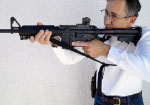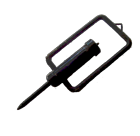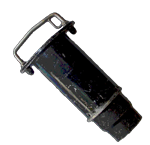By watching riot control techniques from around the world you can see what other countries are doing. Some of their techniques wouldn't be tolerated in the United States and many are illegal here. What you can also learn is what the rioters are doing to thwart law enforcement efforts to control crowds. One of the latest obstacles the Hong Kong Police have faced is the hand held laser.
CBC News reports that pro-democracy protesters are using laser pointers to confuse police officers, scramble facial recognition cameras, and prevent people from shooting photos. Beams of green and blue light can be seen at protests being aimed at law enforcement and their cameras, which can help the government identify protesters using cloud-based, AI-powered facial recognition technology.
The following article from the Harvard Political Review (By Jeremiah Kim | March 19, 2020) is quite informative. If you haven't planned for this you should start.
Lasers were once considered to be tools of the future. While movies like Star Wars and James Bond have traditionally depicted them as science fiction, the days of thinking about lasers as a futuristic tool have come to an end. Protesters around the globe are now using cheap, commercial lasers to confront police, cause disorder, and protect themselves from harm. In Chile and Hong Kong, thousands of protesters have begun using high-powered laser pointers in order to fight back against police forces who openly use rubber bullets and tear gas. Although lasers are used in a similar manner to weapons of warfare, they are justified as novel tools for self-defense because they present a low risk to physical objects and garner media attention.
In the United States, the international trend of using lasers has not caught on and large protest movements have yet to systematically use them for a specific purpose. But, should lasers be considered as a future tool for peaceful protesters to use? There is evidence to suggest that lasers could revolutionize protesting around the world, but the final decision to use a laser or not is fundamentally a personal choice all protesters need to consider.
Why Lasers?
Peaceful movements are often hailed as the best way for citizens to make their voices heard, with the venerated legacies of Dr. Martin Luther King Jr., Nelson Mandela, and Mahatma Gandhi as the gold standard for modern protesters. Peaceful initiatives have proliferated across the United States, throughout Latin America, and more recently, in Hong Kong, especially in the early days of the region’s protests. Yet the oppressive regimes and conditions that protesters are railing against routinely respond to protesters with violence. In the 2019 Hong Kong extradition protests, police forces began to use rubber bullets and tear gas to terrorize and control the movement. Moreover, protesters were assaulted with pepper spray, pepper balls, bean-bag rounds, and sponge grenades. In response, lasers were distributed to protesters en masse for protection.
Lasers are unique because they are deceptively harmless compared to rocks, broken glass, or firearms. For protesters who care more about protecting their identity and defending themselves rather than actively confronting police, a laser seems to be the perfect tool. When an average commercial laser is shined on clothing, nothing happens, but when directed at camera lenses or eyes, lasers become remarkably dangerous because of their concentrated energy. According to opthamologists, they use the same amount of power as a regular incandescent bulb but are immensely more damaging to the eye.
Beyond their ability to distort vision and temporarily blind police, lasers strong enough to create tangible distractions are becoming cheaper and cheaper online. There are an increasing number of websites dedicated to selling high-powered lasers, some for under $20. Although lasers are legally “limited to five milliwatts output power in the visible wavelength range from 400 to 710 nanometers” according to the Food and Drug Administration, lasers with an output power of 3,500 milliwatts, enough to burn through paper, can be found online for $200.
By using lasers against police forces, Hong Kong protesters are building on the precedent set by protesters in the Arab Spring demonstrations. The Arab Spring was a massive protest movement across the Middle East in response to oppressive governance and low standards of living. In 2013, protesters in Cairo’s Tahrir Square used lasers to light up helicopters, buildings, and the night sky in celebration of their protesting. One BBC report even found that the lasers were being sold by street vendors “just for fun.”
The use of lasers in Cairo inspired protesters around the world to incorporate lasers into their own protests. In the summer of 2019, Hong Kong protesters used lasers to protect their identity from the government and blind police officers. Similarly to how they were used in Cairo, Hong Kong protesters also used lasers to celebrate. Later in the year, Chilean protesters took to the streets in response to an increased public transportation fee, massive social inequality, and higher living costs. Akin to Hong Kong, Chilean protesters used lasers to to take down a police drone, blind armed patrol officers, and protect themselves from the use of force by police.
The Hazards of Lasers
Unlike the average 60 milliwatt lightbulb, which emits light in all directions at varying wavelengths, handheld lasers fire at a single wavelength and in a single direction, meaning their power is entirely concentrated into a single beam on a single point. Handheld lasers are particularly dangerous to the retina, the portion of the eye that translates light information into nervous signals the brain can understand. When shined directly onto the eye, the cornea focuses the laser beam onto the retina and the victim may be temporarily blinded. This can also cause headaches and general disorientation. In the most extreme cases, laser pointers may seriously burn the retina, causing permanent blindness.
Dr. Julia Sein, a vitreoretinal specialist from Johns Hopkins hospital, confirmed the medical risks of using lasers in an interview with the HPR. Because the retina contains all of the photoreceptor cells in the eye, which are extremely sensitive to photons and thermal energy, much of the damage that lasers can cause is concentrated in the retina. According to Sein, some of the biggest hazards associated with increased exposure to lasers are long-term blindness, retinal hemorrhages, acute swelling of the retina, and penetration of Bruch’s membrane. However, Sein stressed that even temporary exposure can cause decreased visual acuity and distortion of the central visual field. “I feel like it’s an underdiagnosed problem,” she said in regards to retinal damage caused by lasers.
Sein also expressed reluctance to say that UV protectant glasses are enough to fully protect the eye. “I don’t think there has been a study of people with glasses having lasers shined at them because that would not be ethical … [but] it’s my speculation that [eye protection] does somewhat mitigate the effects of the laser if you were to wear tinted glasses or sunglasses.”
The damage that laser pointers can cause is well known to the Federal Aviation Administration because of the risk lasers present to airline pilots. Since the number of pilots being assaulted by lasers continued to rise in the early 2000s, lawmakers made shining a laser at a commercial plane a federal crime in 2012, and the FBI reported in 2014 that a man was sentenced to 14 years in prison for shining a laser pointer at an emergency transport helicopter. According to a report released by the FAA in January, there were 5,487 documented cases of pilots being assaulted by laser pointers in 2019, and 29 of those incidents resulted in a pilot needing medical attention.
Pitfalls and Uncertainties
Although lasers garner attention, their downfall in the United States lies in their ambiguous legality and how police are trained to respond to protest situations and potential threats. Many protesters are unsure if handheld lasers are legal in public settings, and few are willing to risk being arrested or detained for using a laser, especially when police can use force for perceived threats in certain states. The legality of handheld lasers is further complicated by disparities in legislation between municipalities, states, and the federal government.
When asked how police would respond to the hypothetical use of lasers in protests, Officer Robert Rueca, a spokesperson for the San Francisco Police Department, said that police are trained to respond to certain threats, but that their response depends on the nature of the threat. If protesters began to use lasers to blind police or create disorder, patrol officers would likely respond by treating lasers as a dangerous weapon. Rueca likened lasers to water, saying that police are at liberty to respond to any perceived threats, including water if it is being used in a threatening way. Since the onus to label something as a “threat” falls onto individual police officers, Rueca made it clear that police response to lasers would be subjective and could potentially lead to further police action. Similarly, Jeremy Warnick, the director of communications and media relations at the Cambridge Police Force, said that officers are trained to investigate the source of things that cause bright lights or loud noises, but a police officer could respond forcefully to any protester with a laser if others are being harmed.
Ultimately, the way police respond to all threats depends on the current circumstances, the environment, and the officer’s own experience. In a protest situation, a police response to lasers would depend on how lasers are being used, leaving open the potential for escalation.
The Future of Civil Disobedience
Peaceful civil disobedience grants power to the powerless and emboldens the meek. Regarding the power of protestors, professor Timothy Patrick McCarthy of the Harvard Kennedy School, a well known advocate for LGBTQ+ rights and member of President Obama’s National LGBT Leadership Council, said, “Whenever we talk about ‘peaceful civil disobedience,’ we need to be clear about what protesters are up against in any given context. In the recent cases in both Chile and Hong Kong, that means reckoning with the real violence of increasingly repressive states that police those who are fighting for democracy. This is one of the things that makes ‘peaceful civil disobedience’ so powerful as a tool of protest: the people are disobeying state practices that are neither peaceful nor civil.”
For massive social movements, lasers are the ultimate tool: they cause distractions, they are capable of interfering with police drones, and they provide self-defense. As for the danger they present to human eyes, protesters naturally acknowledge and assume responsibility for the risks of using a laser.
However, lasers are not always necessary for peaceful protesters who want social change. Both the San Francisco  Police Department and the Cambridge Police Department stressed that lasers can easily incite a police reaction, and Sein confirmed that lasers are incredibly dangerous when used improperly. Moreover, lasers can take away from the solidarity that social movements fundamentally rely on.
Police Department and the Cambridge Police Department stressed that lasers can easily incite a police reaction, and Sein confirmed that lasers are incredibly dangerous when used improperly. Moreover, lasers can take away from the solidarity that social movements fundamentally rely on.
Ultimately, the power of civil disobedience lies in a group of people standing together in absolute unity, not from any tool or weapon. Although lasers are remarkably powerful tools, they inherently leave room for irresponsible actors, accidents, and distractions. If the goal of a movement is tangible social change, protesters need to consider if the benefits of using a laser outweigh the potential costs.
Links for additional information
Laser Pointer as Offensive Weapons
Laser pointers and traffic cones
PDF Version of article






